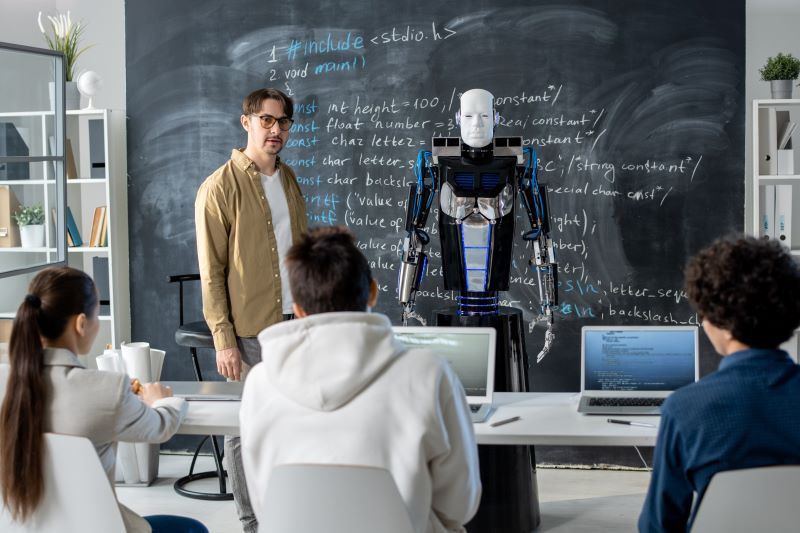We frequently use AI tools in our everyday lives, and yet we still do not feel quite comfortable with them. How can we make use of artificial intelligence in education?
Contact
Agnieszka Nowak-Brzezińska, PhD, DSc. Assoc. Prof. from the Instytute of Computer Science at the University of Silesia – agnieszka.nowak-brzezinska@us.edu.pl
| Author: Tomek Grząślewicz |
Operating billet heaters in hazardous conditions, working with dangerous machinery, handling heavy products in a warehouse…. Without a question, AI-controlled devices should replace us in some of these activities. It could prove difficult for us to get used to travelling in self-driving buses, although autonomous vehicles are already being gradually introduced into public transport. The rapid acceleration in the development of large-scale language models – with the high-profile ChatGPT leading the charge – has, on the other hand, led to a resurgence of discussion on the role of AI tools in university education. Everyone agrees on one thing, though: the model of academic education as we know it is undergoing a radical change right before our very eyes.
Agnieszka Nowak-Brzezińska, PhD, DSc, Associate Professor at the Faculty of Science and Technology of the University of Silesia, places a high value on the possibility of automating a part of her work using ChatGPT. After designing and entering an appropriate range of material, the tool is able to generate several sets of unique questions for a test, a class outline, tips for effective teaching, a report, and final grade suggestions in a split second. Although the results require further verification, the time saved is still significant. AI also has many other advantages.

Phot by pressmaster | Freepik.com
‘Platforms are being developed where teachers can monitor students’ progress’, says Prof. Nowak-Brzezińska. ‘In a group of 25 students, keeping tabs on all the effects of their work is incredibly difficult and often simply impossible to carry out in practice. Whereas, the AI tool is able to detect if a person’s writing style has changed significantly in a week and if their vocabulary has suddenly become exceptionally extensive.
The AI also traverses other limitations of the ‘human factor’. Unlike academics, it works equally effectively in both the first and forty-sixth hour of operation. It is available 24 hours a day, without the need to make an appointment. Provides emotional comfort when a student suffers an educational setback. Evaluates their completed project in exactly the same way as the work created by their classmates. Offers additional assignments, extensive feedback, and many options to individualise learning. The researcher from the University of Silesia emphasises the latter aspect, drawing attention to the fact that modern education puts a strong emphasis on profiling.
‘Traditional teaching methods are based on a uniform approach to all students. Nowadays, the attention begins to turn towards personalised education, i.e. learning process adapted to the individual needs and skills of each student. Artificial intelligence provides a personalised learning experience, tailored to different learning styles. In doing so, we need to remember that AI tools are meant to complement teacher-student interaction rather than replace it.
The accessibility of learning materials is an important issue. A teacher who has recorded their lecture and plans on uploading it to YouTube has the option to add automatically generated subtitles for the deaf. They also have the chance to reach a worldwide audience through translation into one of the dozens of languages offered by ChatGPT.
As with other innovations, there are many questions and concerns surrounding artificial intelligence. There is an ongoing debate in academic circles as to whether AI tools should be used when writing scientific articles. And if so, then to what extent, and in such a case, should the aforementioned ChatGPT be considered a co-author of the text? Regardless of what the answer turns out to be, the scientist reminds that we still have the final say.
‘A human being should always be the one deciding on issues that are important for our lives and conduct. AI can prepare a contract, but a lawyer must verify it. It can draw up a loan application, but a banker must approve it. The same holds true for universities: students should be made aware that an AI tool will bring them closer to a solution, but it isn’t perfect and cannot replace a specialist – the lecturer.
A hundred years ago, the teacher was often the only source of knowledge for students. Nowadays, students acquire knowledge in many different ways, including through AI tools. They can also easily verify the information received in class. There is no way of stopping or prohibiting it. To retain their authority, the teacher must be progressive and open to the change in the approach to education that is happening right here, right now
‘Otherwise, a YouTube influencer who conveys knowledge in a more accessible and attractive way might become the only authority’, Prof. Nowak-Brzezińska warns in conclusion. ‘Poland is well equipped in digital technologies, but we still have a long way to go when it comes to the use of artificial intelligence in education’.
The article entitled ‘AI in the classroom’ was published in the popular science journal of the University of Silesia No Limits no. 1(9)/2024.





